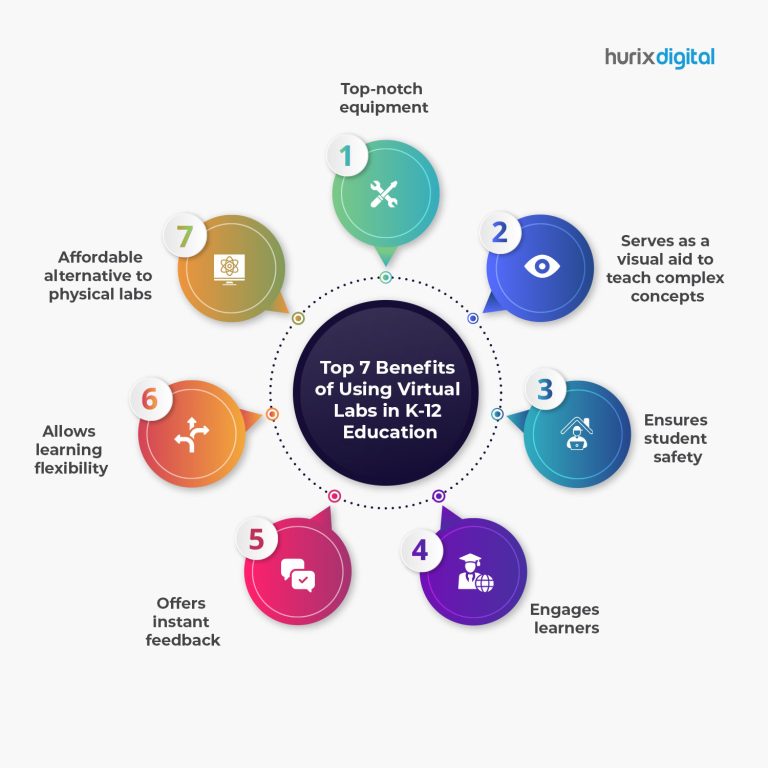7 Benefits of Using Virtual Labs in K-12 Education
Summary
The blog post explores the advantages of using virtual labs in K-12 education. It highlights how virtual labs provide students with hands-on learning experiences in a safe and cost-effective manner, regardless of their physical location.
Over the last few years, the education industry has witnessed a significant transformation in terms of learning methods and techniques, making it imperative for educational institutions to keep up the pace and prepare students adequately.
One of the ways technology has benefited K-12 education in particular is the emergence of virtual labs. In this blog, we explore the concept of virtual labs in more detail, along with the benefits of using a virtual lab in K-12 education.
Table of Contents:
- What are Virtual Labs?
- What are the Categories of Virtual Laboratories
- Benefits of Using Virtual Labs in K-12 Education
1. Top-notch equipment
2. Serves as a visual aid to teach complex concepts
3. Ensures student safety
4. Engages learners
5. Offers instant feedback
6. Allows learning flexibility
7. Affordable alternative to physical labs - Conclusion
- Frequently Asked Questions (FAQs)
What are Virtual Labs?
Virtual lab refers to a virtual teaching and learning environment aimed at developing students’ laboratory skills. As one of the most important eLearning tools, they allow the student to conduct various experiments without any constraints to place or time, in contrast to the constraints of real labs.
Virtual labs incorporate various pedagogical techniques that help learners to better understand the theoretical information. These techniques include visual learning, active learning, recall-based learning, gamification & storytelling.
They also offer students access to a realistic lab experience that will allow them to perform experiments and practice their skills in a risk-free and interactive learning environment.
Categories of Virtual Laboratories
Virtual laboratories are not homogenous, and they largely differ in their purpose, composition, and application.
In general, a virtual lab in modern academia can be divided into the below categories:
- Laboratories: These are the platforms that simulate physical labs on screens. The online experience offers the students the same facilities as in the physical lab, with the only difference of the interaction being limited to a 2D environment
- Simulations: Simulations offer students an opportunity to explore a different reality from a remote location
- VR spaces: VR or virtual reality classes offer a more immersive experience than simulators
Also Read: How K-12 Learning Solutions Help Teachers and Students?
Top 7 Benefits of Using Virtual Labs in K-12 Education

1. Top-notch equipment
Virtual labs offer K-12 students with easy access to cutting-edge technology for experimentation. Tools such as Simulations and Virtual Microscopes provide futuristic solutions to science students.
Learners do not have to settle on outdated equipment with a virtual lab in place and can instead work with AI-powered laboratories and modern teaching techniques. They can easily compete with peers using advanced technological solutions.
Further, these labs can help the teacher cover various aspects of the course curriculum with practical applications. It allows students to understand the concepts better, which is otherwise difficult to offer with limited equipment and funding.
2. Serves as a visual aid to teach complex concepts
Using virtual labs, teachers can easily explain complex theoretical concepts to students through a visual, immersive experience that can make it simpler for students to understand.
Moreover, it provides the synchronization needed between explaining theoretical ideas and practical applications.
3. Ensures student safety
Students can try various kinds of experiments in a virtual laboratory without the risk of injuring themselves or damaging equipment. They can also test multiple scenarios, compare, and determine which one is the most effective without trying them in real life.
Designed with the latest technology, virtual labs protect students from the dangers they face while conducting some dangerous laboratory experiments. Further, it also eliminates the need to deal with toxic/radioactive chemicals and other similar hazards and offers an effective way to avoid laboratory accidents.
4. Engages learners
Listening to lectures and watching presentations about experiments can eventually become disinteresting for students. Virtual labs allow the instructors to capture learners’ attention by allowing them to test all those procedures in an online setup easily.
Students can conduct the same experiment multiple times to ensure they completely understand the concept.
5. Offers instant feedback
Another advantage of virtual labs is that it allows students to redo the experiments. Unlike the traditional lab setup, in virtual labs, experiments no longer have a single chance option. Students can go over their mistakes, analyze what went wrong and give it another shot immediately.
Since all the experiment results are recorded, maintaining communication between teachers and students becomes more efficient.
6. Allows learning flexibility
One of the most common benefits of online learning is that students can learn at their own time and pace. The same applies to virtual laboratories also. It helps students study, prepare and perform laboratory experiments at any time and place at their convenience.
Since all virtual labs are cloud-based or accessible via the web, they offer students unhindered access to the platform whenever they want. Students can also access the laboratory on any device from any location, making them indispensable for contactless learning.
7. Affordable alternative to physical labs
Online or virtual labs are far less expensive as compared to real ones. One single lab platform can serve an entire school or institution without spending a massive amount of resources on its development. Besides, schools also don’t need to worry much about maintenance costs and other similar expenses.
Also Read: How to Implement 3D Learning in K-12 the Right Way?
To Conclude
With the changing educational landscape, K-12 educators are constantly exploring innovative ways to fine-tune their online learning processes.
Virtual labs are excellent digital resources that help to save costs and enhance student productivity manifolds. Moreover, they allow students to take part in school work from any location and seamlessly combine the convenience and ease of use offered by contemporary technology. While virtual labs still need some improvements to replicate the physical laboratories, it won’t be wrong to say that they are here to stay.
To make your K-12 learning initiatives more streamlined, you can get in touch with Hurix Digital. Hurix Digital‘s team of experts assists you in developing effective programs.
Frequently Asked Questions (FAQs)
1. What subjects can be taught using virtual labs in K-12 education?
A. Virtual labs can be used across various subjects, including biology, chemistry, physics, environmental science, and even engineering.
2. Will virtual labs replace traditional hands-on laboratory experiences?
A. While virtual labs cannot fully replace traditional hands-on laboratory experiences, they can complement and enhance them. Virtual labs offer opportunities for pre-lab preparation, reinforcement of concepts, and remote learning.
3. What types of experiments can be performed in virtual labs?
A. Virtual labs can simulate a wide range of experiments, including chemical reactions, biological processes, physics simulations, data analysis, and dissections. They often incorporate interactive features, simulations, and data collection tools to provide an engaging and realistic experience.
4. How can virtual labs cater to different learning styles in K-12 education?
A. Virtual labs offer flexibility and interactivity that cater to different learning styles. They provide visual and auditory representations of experiments, interactive elements for kinesthetic learners, and self-paced learning options to accommodate individual student needs and preferences.
5. How can virtual labs support remote and distance learning in K-12 education?
A. Virtual labs are particularly valuable for remote and distance learning. They enable students to access laboratory experiences from anywhere, providing equitable opportunities for learning.
Need to know more about our Products & Services? Drop us a Note.
We respect your privacy. We use the information you provide us to send you relevant content about industry trends and our products & services. You may unsubscribe from our list at any time. For more information, check out our Privacy Policy









